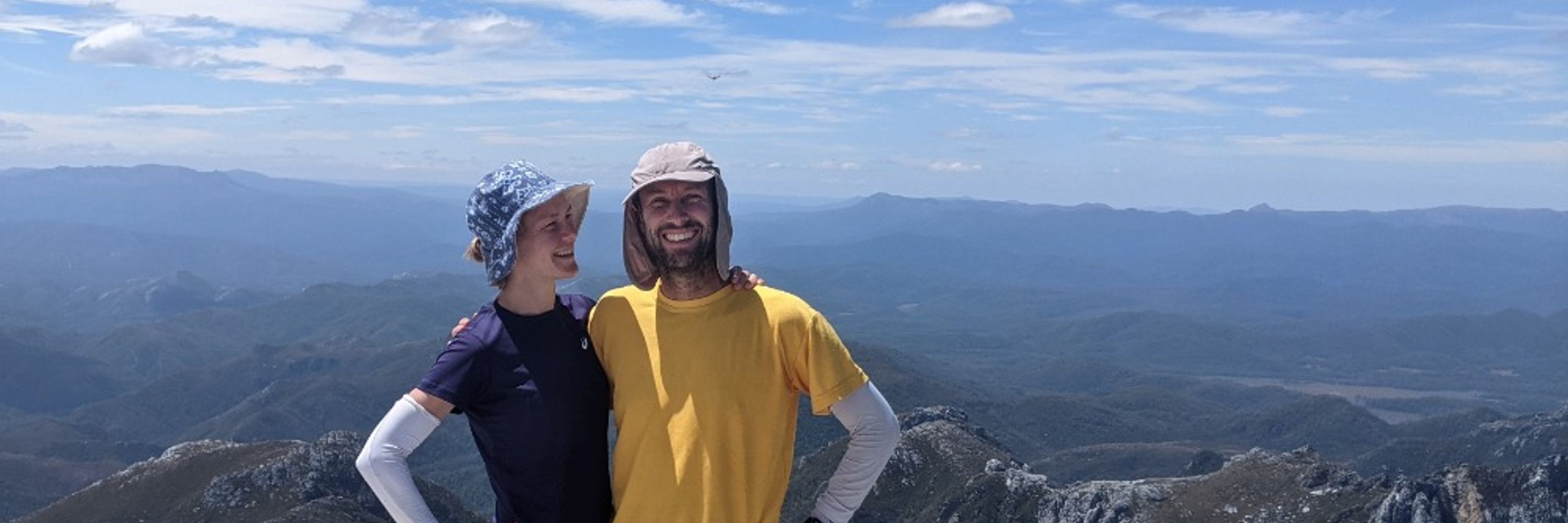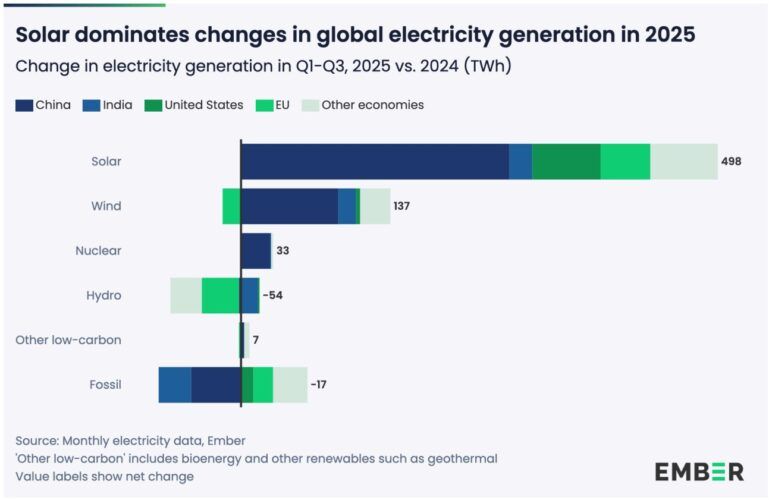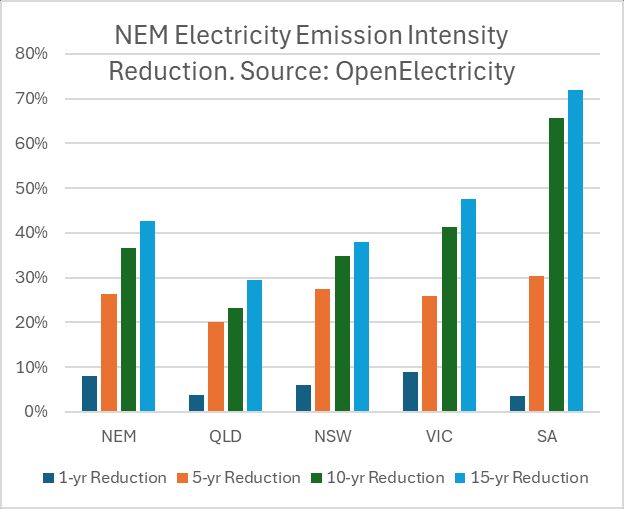
Keen on renewables, efficiency, EVs, bikes, the outdoors, running & cycling

Results:
Last week: 100% RE
Last 220 weeks: 98.6% RE (1/5)
Govt says it is the biggest annual drop in gross emissions recorded (ie not counting land/forests).
This has been put out ahead of a dump of climate documents and Chris Bowen making his annual climate statement.

Govt says it is the biggest annual drop in gross emissions recorded (ie not counting land/forests).
This has been put out ahead of a dump of climate documents and Chris Bowen making his annual climate statement.
Results:
Last week: 100% RE
Last 222 weeks: 98.6% RE (1/5)

Results:
Last week: 100% RE
Last 222 weeks: 98.6% RE (1/5)
Results:
Last week: 100% RE
Last 221 weeks: 98.6% RE (1/5)

Results:
Last week: 100% RE
Last 221 weeks: 98.6% RE (1/5)
www.theguardian.com/australia-ne...

www.theguardian.com/australia-ne...
10 years later, and coal's generation increased by the FOURTH most.
Solar #1, wind #2 💪💪💪
Solar rose from providing 1% of global electricity in 2015 to 8.8% in the first half of 2025.
Emerging economies now lead this growth 📈
https://loom.ly/tlCvBso

10 years later, and coal's generation increased by the FOURTH most.
Solar #1, wind #2 💪💪💪
It had high prices due to lack of cheap coal, peaky demand & lots of poles per customer. threadreaderapp.com/thread/16688...
It had high prices due to lack of cheap coal, peaky demand & lots of poles per customer. threadreaderapp.com/thread/16688...
Shows that the growth in solar and wind generation is finally starting to exceed the growth in demand, so that fossil generation is declining.
That is true in both China & India, as well as globally.

Shows that the growth in solar and wind generation is finally starting to exceed the growth in demand, so that fossil generation is declining.
That is true in both China & India, as well as globally.
www.theguardian.com/environment/...

www.theguardian.com/environment/...
Results:
Last week: 100% RE
Last 220 weeks: 98.6% RE (1/5)

Results:
Last week: 100% RE
Last 220 weeks: 98.6% RE (1/5)
Results:
Last week: 100.0% RE
Last 219 weeks: 98.6% RE (1/5)

Results:
Last week: 100.0% RE
Last 219 weeks: 98.6% RE (1/5)
Average NEM emission intensity over last 12 months: 529 kg CO2-e/MWh
(down 26% in 5-yrs, down 37% in 10-yrs)
Sth Australia leading the way reductions thanks to its increase in wind & solar generation.
Down 30% in 5-yrs, 66% in 10-yrs)


Average NEM emission intensity over last 12 months: 529 kg CO2-e/MWh
(down 26% in 5-yrs, down 37% in 10-yrs)
Sth Australia leading the way reductions thanks to its increase in wind & solar generation.
Down 30% in 5-yrs, 66% in 10-yrs)
Results:
Last week: 100% RE
Last 218 weeks: 98.5% RE (1/5)

Results:
Last week: 100% RE
Last 218 weeks: 98.5% RE (1/5)
Results:
Last week: 100.0% RE
Last 217 weeks: 98.5% RE (1/5)

Results:
Last week: 100.0% RE
Last 217 weeks: 98.5% RE (1/5)
www.worldscientific.com/worldscibook...
www.worldscientific.com/worldscibook...
#AtlasNetwork
www.rainforestreserves.org.au/media-releas...

#AtlasNetwork
www.rainforestreserves.org.au/media-releas...
Results:
Last week: 100% RE
Last 216 weeks: 98.5% RE (1/5)

Results:
Last week: 100% RE
Last 216 weeks: 98.5% RE (1/5)
www.abc.net.au/news/2025-10...

www.abc.net.au/news/2025-10...
Related to this, it's worth noting that ACCUs are currently trading for $38 while just $11 for LGCs. I'd argue that LGCs offer better quality carbon offset for less than 1/3 price
/1
Our new report finds that Australian household energy bills are set to halve by 2050, leaving room for the federal gov't to cut emissions in the electricity sector without hurting households.
Here’s how: buff.ly/9UPN4ub

Related to this, it's worth noting that ACCUs are currently trading for $38 while just $11 for LGCs. I'd argue that LGCs offer better quality carbon offset for less than 1/3 price
/1
To paraphrase Groucho Marx, who'd want to belong to a club that would accept Responsible Wagering Australia as one of its sponsors?

To paraphrase Groucho Marx, who'd want to belong to a club that would accept Responsible Wagering Australia as one of its sponsors?
Results:
Last week: 100% RE
Last 215 weeks: 98.5% RE (1/5)

Results:
Last week: 100% RE
Last 215 weeks: 98.5% RE (1/5)
It’s the process, says @timdunlop.bsky.social, not Andrew Hastie per se.
tdunlop.substack.com/p/i-suppose-...

It’s the process, says @timdunlop.bsky.social, not Andrew Hastie per se.
tdunlop.substack.com/p/i-suppose-...
The cost of the scheme is negatively correlated to the wholesale electricity price, providing ACT consumers a valuable shield against volatile electricty prices.
/1

The cost of the scheme is negatively correlated to the wholesale electricity price, providing ACT consumers a valuable shield against volatile electricty prices.
/1
Sth Australia leading the way in reductions, down 29% over the last 5-years, down 66% over the last 10-years.



Sth Australia leading the way in reductions, down 29% over the last 5-years, down 66% over the last 10-years.
Results:
Last week: 100% RE
Last 214 weeks: 98.5% RE (1/5)

Results:
Last week: 100% RE
Last 214 weeks: 98.5% RE (1/5)

